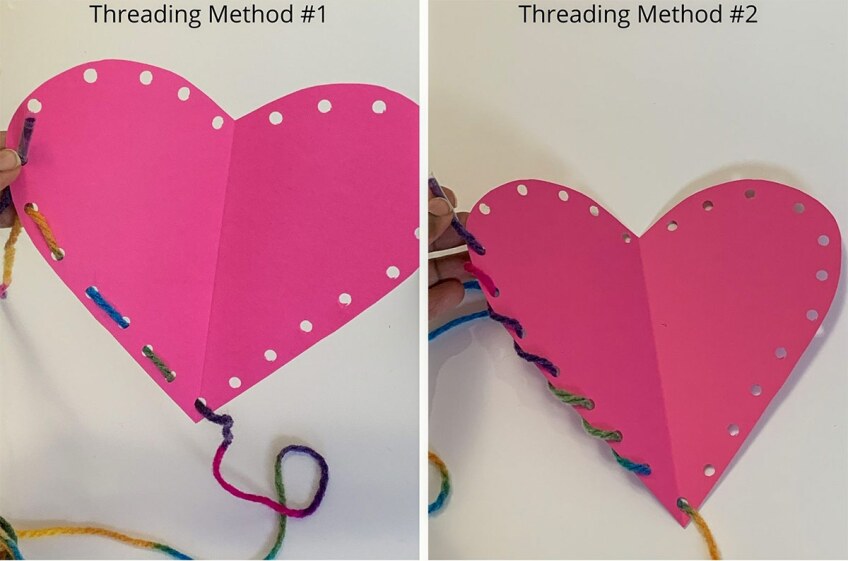Be Mindful: A Kids Valentine’s Day Craft from the Heart

They say distance makes the heart grow fonder. I like to think that distance just allows us to be more creative about the ways we can show appreciation for the one’s we’re fond of, especially around Valentine’s Day. So, this year, let’s shift the traditional message of “be mine” to “be mindful” as we make heartfelt handmade valentines with our little ones. Making their own valentines allows children to express the love and gratitude they have for those they care about in a creative way.
Learning Goal
This activity will help your child:
- Identify shapes and colors
- Use hand-eye coordination
- Strengthen fine motor skills
- Practice gratitude and mindfulness
Materials
- Cardstock or construction paper
- Pencil
- Scissors
- Single hole puncher
- Yarn (ribbon and shoe laces work great, too)
- Tape
Optional Materials
- Markers, crayons and/or colored pencils
- Craft supplies
- Plastic sewing needle
Step-by-Step Instructions
1. Fold the cardstock paper in half. Using a pencil, trace half of a heart on the folded side.
This is a good opportunity to discuss who the child will be making the card for. Have them express gratitude by pointing out some qualities they love about that person. Here are some conversational cues to help get them started:
- “They are kind.”
- “They have a big heart.”
- “They’re going to love this card you’re making for them.”
You can also talk about the color they’ve selected for their paper and why they chose it.
2. Use the scissors to cut along the outline of the half heart. Once you unfold the paper, you now have a full heart!
3. Ask your child questions such as:
- “How many half hearts did we start with?”
- “How many half hearts make a full heart?”
4. Punch holes along the perimeter of the heart using the hole puncher. Smaller children may require assistance for this step. Feel free to use this opportunity to have the child point out what shape the hole punch is making. You may even practice counting the holes.
5. Prepare your yarn for sewing! Take a piece of tape and wrap it around the end of the yarn. This step may be optional if you’re using thin yarn, but is necessary for thick yarn, as it will allow children to thread it through the paper with ease. Using a plastic sewing needle instead of tape is a fun, alternative way to make the activity more challenging for older kids.

6. Thread the yarn through the holes of the paper. For this step there are two design options:
- The first one is to thread the yarn in an in-out pattern, through the hole from the front of the heart and back out through the next hole.
- The second is a wraparound method, where you thread the yarn through one hole and wrap it around the outside of the heart as you repeat the pattern with the next hole.
Encourage the child count each hole they thread their yarn through.

Once you’re finished threading the entire perimeter of the heart, cut and tie a knot around the yarn to ensure it doesn’t unravel.
7. Decorate! Using any crafting supplies you have on hand, decorate the middle of the heart. Be as creative as you’d like!

8. Send some love. You can drop your valentines off for loved ones who are near and mail them to those who are far away.
Keep the Conversation Going
Have the child identify where their heart is located in their body. Ask them if they can feel their heart beating in their hand. Is it beating fast or slow? These questions can be repeated after doing various activities as a way to allow them to pause and check in with their heart.
Use the threading process to practice a breathing exercise. Try having your child inhale through their nose as they thread the yarn through one hole and exhale out the mouth as they thread the next hole.
Book Suggestions
- “My Heart Fills with Happiness” (Ages 0-2) written by Monique Gray Smith and illustrated by Julie Flett
- “Windows” (Ages 3-7) written by Patrick Guest and illustrated by Jonathan Bentley
- “The Invisible String” (Ages 4-8) written by Patrice Karst and illustrated by Joanne Lew-Vriethoff



